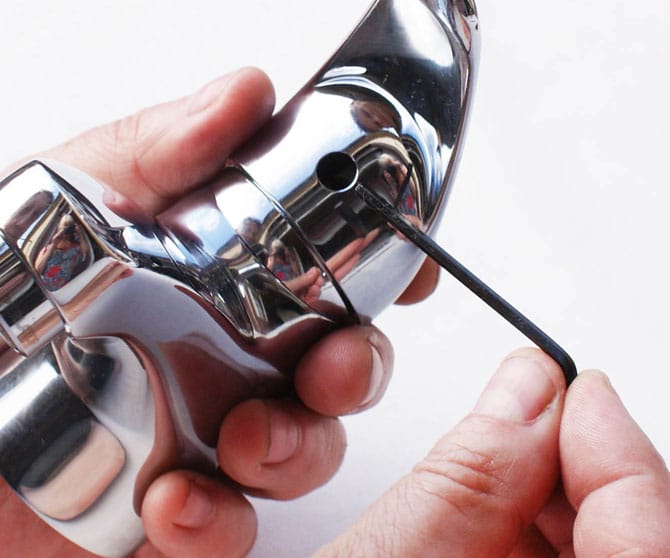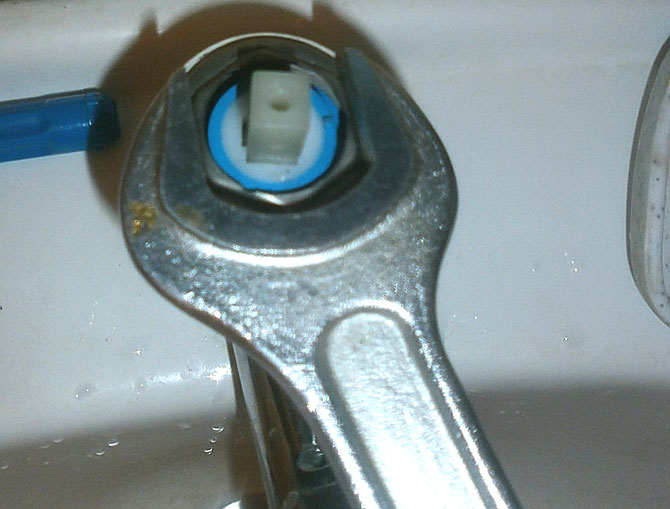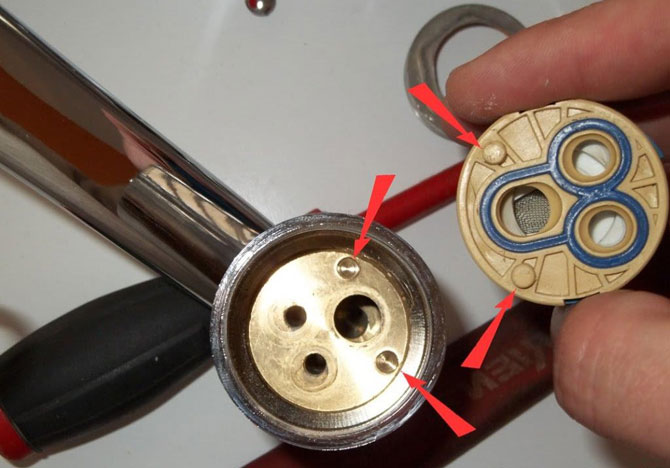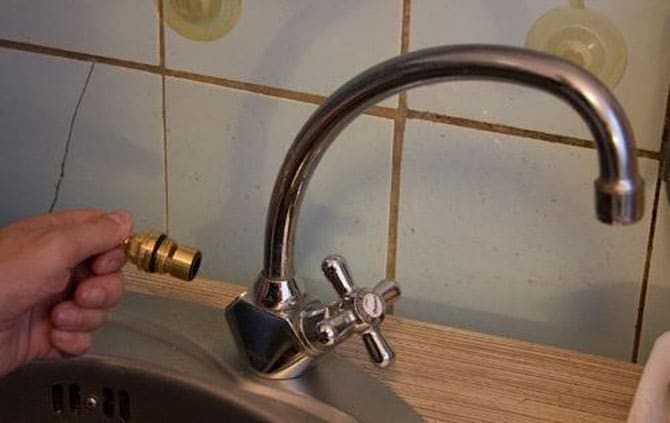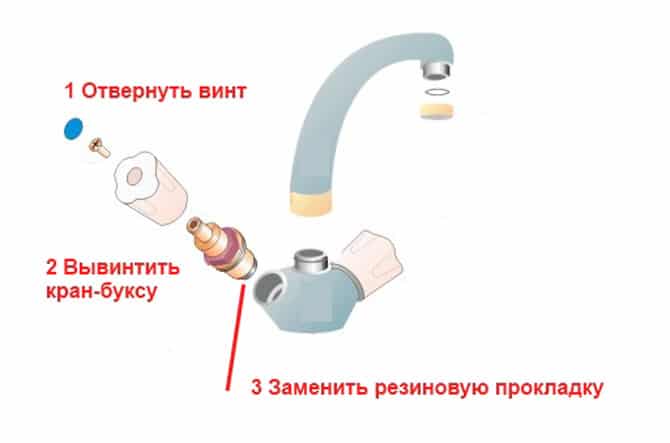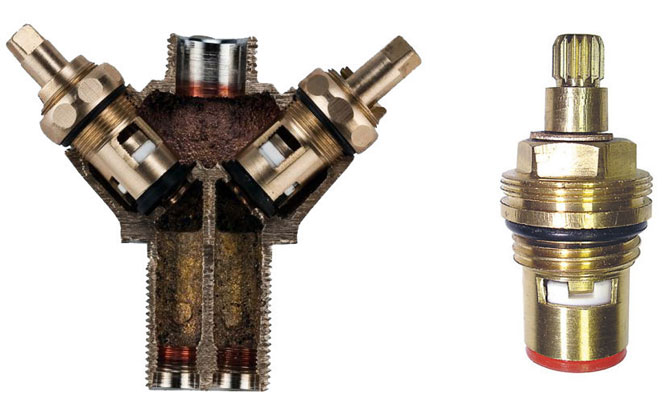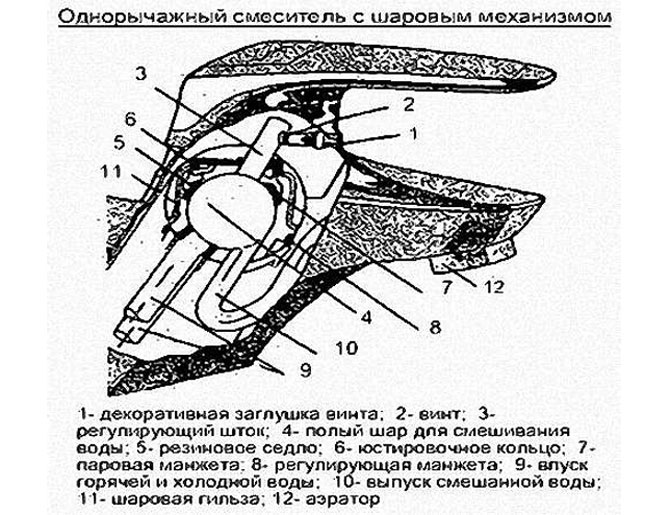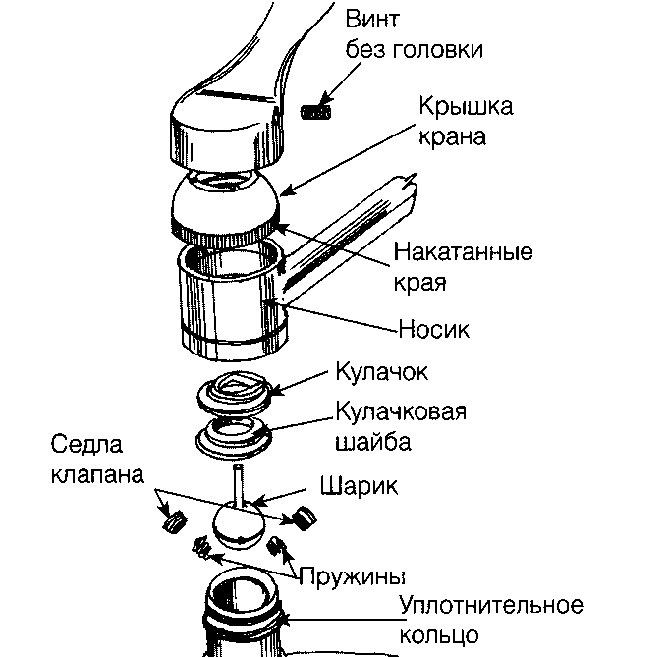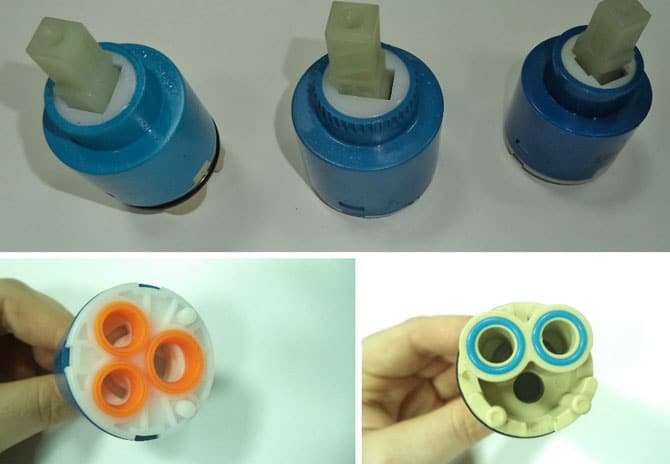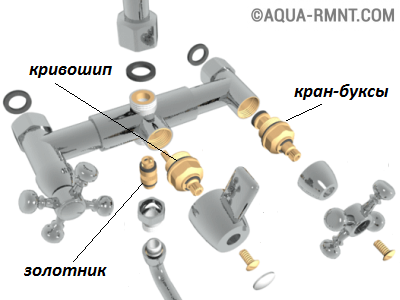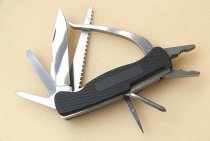Faucet repair step by step
So, consider what needs to be done to repair a kitchen ball valve?
Ball valve video repair
There is a specific crane repair sequence that cannot be changed. After all, the success of the repair will depend on how accurately all recommendations are implemented.
The main stages of repairing a ball-type mixer are the following operations:
- Turn off the water supply first to prevent water leakage. Drain the remaining water that remains in the mixer;
- loosen the screw that should hold the mixer lever. To do this, unscrew it with a hex wrench. Remove the lever by pulling it up and loosening it at the same time. If your faucet has been in use for a long time, then you may need to put in some effort. But at the same time, be extremely careful, since the quality and strength of handles and bodies in inexpensive mixers leaves much to be desired;
- now that you have removed the lever part, you have access to the threaded connection. Turn it clockwise with a screwdriver, applying some force. At the same time, be extremely careful and careful not to damage the water pipes;
- remove the faucet dome with pliers and remove the small plastic part that is located under it;
- if a faucet leaks, then the problem is most likely in the condition of the seal, which can either be worn out (most often) or blocked by mineral deposits (if the water supply is too hard). Deposits are easy to remove with non-abrasive cleaners;
- remove the ball from its attachment point. If it is found to be deformed or damaged, it may need to be replaced;
- dismantle the seals that fix the ball. They are easy to remove with a sharp flathead screwdriver. Change them to new ones, it is also advisable to replace the springs, which gradually lose their elasticity over time and cease to fix the ball with high quality;
- lubricate new seals to prolong their service life.
After the seals are replaced, assemble the mixer according to the instructions. To do this, first install the steel ball, followed by the flywheel and casing. Be sure to carefully check the tightness of absolutely all connections, connecting access to cold and hot water. If the water does not flow anywhere, the pressure is strong enough, the temperature is easily regulated, and the pipes do not hum, then this means that the repair was successful and the problem was fixed!
The faucet in the kitchen is leaking how to fix it yourself
To repair a kitchen faucet you will need:
- knife with a sharp end;
- hex and adjustable wrench;
- screwdrivers;
- a new cartridge, a crane box, a rubber gasket, etc. - depends on which part you will be changing;
- WD40 is a technical aerosol that will come in handy if the parts are “sticky” to each other. However, you can get by with the traditional tapping of a hammer on a screwdriver, but there is a high risk of damage to the mixer.
Regardless of which faucet you have installed, before starting repairs, you must turn off the water supply in the system and drain its remnants into a sink or a separate container. To do this, just open the tap. Then you can begin to repair it, taking into account the design features.
To repair a single-lever faucet, you will need a hex wrench
Single lever kitchen faucet repair
The main principles of repair are the sequence of actions and accuracy.
- Using a thin screwdriver or a knife, pry and remove the decorative cap on the faucet body.
- In the resulting hole, you will see a screw connecting the lever and the adjusting rod. Unscrew it with a hex wrench.
- Remove the lever from the body and unscrew the decorative cover. This can be done even by hand, if the parts are not stuck to each other.
Removing the decorative cover
- A locking (clamping) nut will be located under it. Carefully unscrew it with an adjustable wrench or by tapping a screwdriver with a hammer.
- If you disassemble the ball mixer, you will see a sealing cuff under the nut. Inspect it for dirt, deformations and breaks. Pull out the ball. Inspect its surface - it should be smooth and clean. It is necessary to remove the seals and supporting springs - their poor condition can cause the tap to leak.
- If you are disassembling a faucet with a cartridge, then remove it and subject it to a thorough inspection.
- Replace the failed part.
- Reassemble the faucet in reverse order.
Installing a new cartridge
To extend the life of the product and ensure the smooth running of its rubbing parts, you can use a special silicone lubricant.
Removing the mixer flywheel
Repair of a two-valve mixer
What to do if you have a two-valve faucet dripping in your kitchen? Almost everything is the same.
- On the valve flywheel, pry off and remove the decorative cap.
- Using a screwdriver, unscrew the screw that secures the flywheel.
- Take off the flywheel. In front of you will be a crane box.
- Unscrew it counterclockwise and inspect it.
Removing the crane box
- If this is a worm-type axle box and the gasket is damaged, replace it separately - buy it in a store (it costs a penny) or cut it yourself from rubber of suitable thickness. The axle box with ceramic discs is changed entirely.
- Assemble the faucet in reverse order.
The general scheme of work on the repair of the mixer
Everything is as simple as possible and slightly resembles a designer. But a faucet leak is not the only problem you may encounter while using it in the kitchen.
Other faucet breakdowns and troubleshooting
The quality of water in many cities leaves much to be desired, so over time, the aerator in the tap can become dirty. From the inside, solid deposits “grow” on it. When there are too many of them, the pressure and quality of the water deteriorate significantly. The solution to the problem is to replace the aerator. Ideally, it can be easily unscrewed with an adjustable wrench, but for a stuck part, you will need WD40 or tapping with a hammer.
The faucet is leaking, and during the inspection you found a crack in it? Then it's time to go for a new product. For a short time, silicone sealant can become an assistant.
You can extend the life of the mixer if you install a water filter and use the device carefully, without twisting the valves too much and without moving the lever sharply and all the way.
Features of the device of the main types of kitchen faucets
Cool things like thermostatic and touchless faucets are good for bathrooms. In the kitchen, more practical models are fighting for a place in the sun - traditional two-valve and single-lever. Common elements for them are: body, spout (spout), aerator, sealing gaskets. Otherwise, they differ significantly.
The device of two-valve cranes
Familiar to the eye taps with two valves are arranged quite simply. Under the flywheel, which you turn during the operation of the structure, there is a crane box - its locking element. Below is a device of such a kitchen faucet in pictures.
Boxes in a two-valve mixer (in section)
In products where several turns of the flywheel are required to supply or shut off water, worm axle boxes are installed. Their work is based on rotational-translational movements. The more you unscrew the valve, the more the axle box gasket will move away from the so-called "saddle". The consequence of this is the flow of water into the internal cavity of the mixer, and then into its spout (spout).
Worm-driven faucet for mixer
In models where only half a turn is enough to supply water, axle boxes with ceramic plates are installed. When the faucet is opened, the holes in them coincide, and water flows into the spout.
Crane boxes with ceramic plates
The cost of faucets is low, they are always available in plumbing stores, and their replacement is extremely simple.
The device and types of single-lever mixers
More modern and practical are faucet models with one handle (lever) that regulates pressure and temperature. Mixing of water in them is carried out in a hollow ball with three holes or in a special cartridge.
The mixing element in spherical models has three holes, two of which are inlet - designed to enter this miniature container of hot and cold water, and one outlet - to supply water of a given temperature to the sink.
Ball mixer device
The ball itself is located on two "saddles" of rubber. Its displacement relative to them, carried out when the lever moves, and allows you to adjust the pressure, the temperature of the poured water. From above, the ball is fixed with a sealing cuff and a lock nut.
Schematic arrangement of a spherical model of a kitchen faucet
The principle of operation of a mixer with a cartridge that replaces the ball is similar. At the same time, their internal structure is fundamentally different. All the same three functional holes are available, but inside the cartridge there is not a cavity, but special discs made of cermet. Due to their displacement relative to each other and the degree of overlap of the supply holes, when the lever is turned, the water supply is adjusted.
Replaceable ceramic cartridges
Ball valve is the most popular option
The most common mixer design today can be safely called a ball valve. It is a mechanism with one rotary handle. When moving the handle up and down, the pressure of water is regulated, to the right and left - its temperature. The popularity of such a device is explained not only by the simplicity and convenience of its operation, but also by increased reliability.
Single lever mixer device
In order to answer the question "how to repair a ball mixer", you need to understand how the system works. This is how the ball valve looks in section.
This is done according to the following algorithm:
- Shut off and drain the water;
- We dismantle the mixer;
- Pry off the decorative plug with a knife or screwdriver and remove it;
- We unscrew the screw;
- We remove the lever;
- We take out the cartridge and install a new one in its place;
- We make assembly.
That's all. Now your faucet will work like new for sure.
Blockage in the aerator
When the water in the bathroom flows in a thin stream, and in the kitchen it beats with a powerful stream, there is no need to talk about the fault of the water utility. So, how to fix a bathroom faucet if the water pressure has dropped? The most common and easily remedied cause of such a problem is a clogged aerator.
Checking if this is your case is very simple. Unscrew the aerator and open the faucet. If the water pressure returned to normal, the culprit was found. It is better to replace a very rusty aerator, but it is enough to rinse just a clogged one, directing a jet of water to its outer surface. Now install the part in place and you're done.
Blockage in a water pipe or hose
If simple manipulations with the aerator did not work, the pipe or hose is most likely clogged. Quite often, in houses with old metal pipes, rust that has fallen off their inner surface blocks the section, which leads to a drop in pressure in the mixer. Cleaning the pipes will help to cope with the problem, but it is still better to replace them with plastic ones. The inner surface of modern pipes made of polymers is very smooth and not subject to corrosion, which means it does not “overgrow”.
If there is no opportunity to replace the pipeline yet, arm yourself with a thin “snake” cable, disconnect the pipe from both sides and start cleaning.
Problems with the shower-bath switch
Now let's move on to the answer to the question of how to repair the faucet in the bathroom if the water supply to the shower stops by itself. The switch lever spontaneously lowers and water flows only through the faucet.
The cause of such a malfunction may be the wear of the spool gaskets. If only the top gasket is damaged, you will not have to remove the mixer. Since it is impossible to determine this “by eye”, for a start it is worth replacing it, and only then draw conclusions:
- Unscrew the union nut of the hose and remove it;
- We hook the gasket with a thin hook or awl;
- We moisten the new gasket with water and install it in place;
- We collect the mixer.
If the damage could not be eliminated in this way, you will have to change the bottom gasket:
-
- We block the water;
- Remove the flexible hose by unscrewing the union nut;
- Remove the spout and adapter;
- Remove the switch and remove the eccentric;
- We take out the spool;
Remove the bottom gasket with a thin screwdriver or hook (the top one has already been replaced);
If the top spool seal has already been replaced, this does not need to be done again.
- We put on a new gasket, moisten it with water and install the spool back;
- We collect the mixer.
In the kitchen, the faucet is used much more actively than in the bathroom, so it fails much more often. In rare cases, the only solution to the problem that has arisen is the purchase of a new appliance and the invitation of a plumber, in the rest you can handle it yourself. Having decided to repair the faucet in the kitchen with your own hands, you will save on the services of a specialist and gain important experience. You just need to arm yourself with theory and tools.
- Leakage from under the nut at the point where the water is poured out, from under the handle (lever) or mixer taps in working order.
- The correct movement of the lever or valves is violated (they stick, scroll, do not lock in the desired position, etc.).
- With normal water pressure in the system, the jet is not powerful enough.
- Water drips from a closed faucet.
The most common problem is a leaky faucet. And here you need to know the "enemy" not only in person, but also from the inside. It's about mixers.
Device
To understand how to disassemble a ball valve, you should study its design. On fig. 1 and 2 shows a diagram of the design of a single-lever ball valve.
Figure 2. Ball valve assembly diagram.
Ball mixers are distinguished by their reliability and durability due to the non-separable cartridge included in their design. All parts of the mixer are adjusted very precisely relative to each other. However, such mixers still sometimes fail. Knowing the device of such cranes and understanding the principle of their operation will help you easily cope with their disassembly and repair. On fig. 3 shows a diagram of the principle of operation of a ball mixer.
The design of such mixers is based on a hollow ball with holes and a pin for attaching it to the handle. Cold and hot water is supplied to this ball through two water pipes, after which, mixed in it, it enters the spout.
When the lever is turned left or right, the supply of hot or cold water is adjusted by closing the holes in the ball. Similarly, by raising and lowering the lever, you can adjust the force of the water pressure.
Problems with the operation of the ball mixer
What are the most common problems when using a ball type mixer?
Apart from those cases when the cause of the breakdown is mechanical damage, that is, there is a crack in the case or there is a problem with the water supply, for example, rusty water constantly flows, the most common problems are the following.
The most common problems:
- weakened pressure, provided that the pressure in the water supply system has not decreased;
- water leak;
- heavy temperature regulation (impossible to set warm water).
The most common problem is a mixer leak. Its cause is the clogging of the space between the ball and the seats in the cartridge. Even a microscopic mote can break the tightness of the valve and subsequently deform the saddle.
The pressure is not difficult to regulate by changing the position of the rod connecting the lever and the ball to each other. By changing the position of the stem, it is possible to set the position of the pipes in such a way as to provide the necessary pressure in the tap.
There may also be problems due to clogged shutter. This problem is easily solved by taking the aerator out, cleaning it and returning it to its original position. In order to avoid blockages in the future, it is necessary to install water filters that can trap solid elements that clog the faucet.
Video repair single-lever mixer tap with ceramic cartridge
Now you know what to do if the faucet drips in the kitchen. In most cases, the considered repair schemes are also suitable for eliminating breakdowns of faucets in bathrooms. This is a good savings for the family budget. But if you are not confident in your abilities or you simply do not have time, a competent plumber will do all the work in a matter of minutes.
May 30, 2015
There are many types of faucets and faucets. In recent years, ball type valves and mixers have become very popular.
Ball valves are distinguished by their reliability, but sometimes certain breakdowns occur in them. And when it is necessary to make an urgent repair of a ball valve, even experienced locksmiths are lost. This is due to the design features of this crane model, which is quite complex.
In conventional cranes, everything is extremely simple. It is necessary to unscrew a couple of nuts, replace a leaky gasket or a faucet box, tighten the nuts back and check the faucet for leaks. But the ball valve model can make you sweat a lot, especially if a person who does not have special training and work experience undertakes repairs.
In general, suppose that there has been a minor accident on a ball valve or mixer installed in your home, and you need to fix it yourself in an extremely short time.
This situation is very common, since the mechanism of this faucet, in addition to considerable advantages (in the form of very accurate and fast adjustment of the temperature and power of the water flow), also has some disadvantages. A number of factors, which will be discussed below, lead either to leaks or to the fact that it stops mixing the water temperature correctly. This is the main breakdown of the ball type valve.
